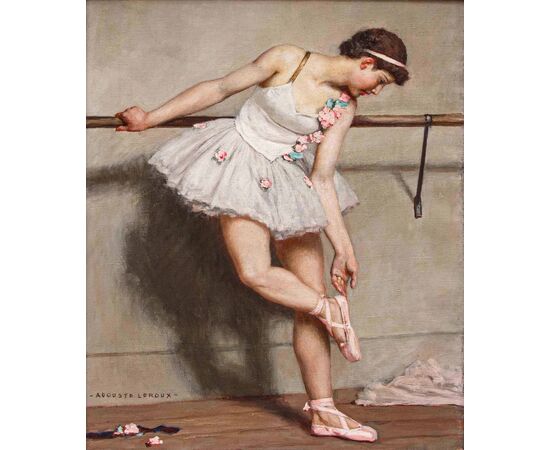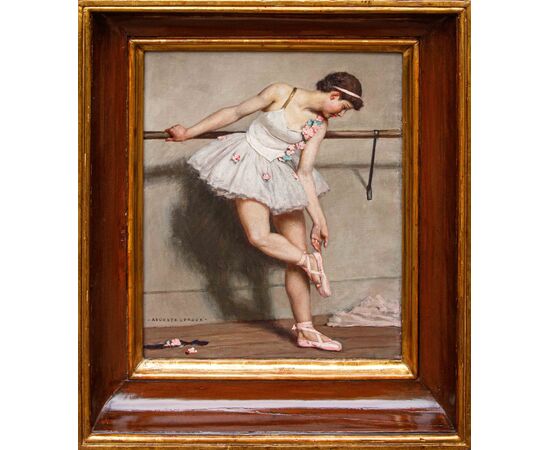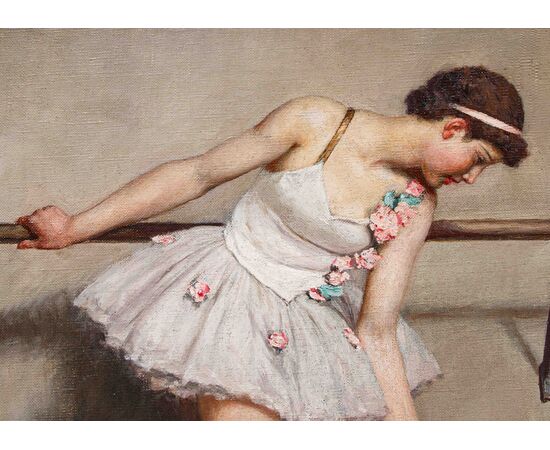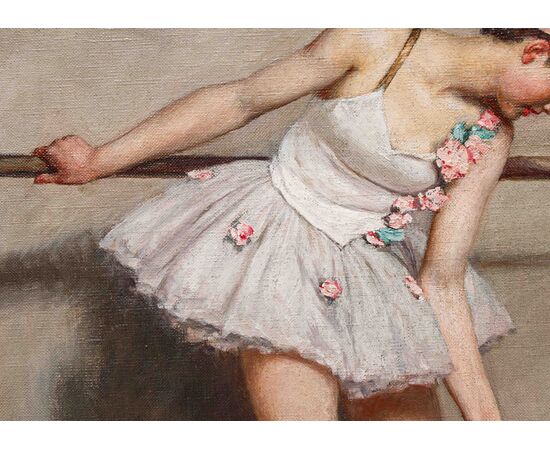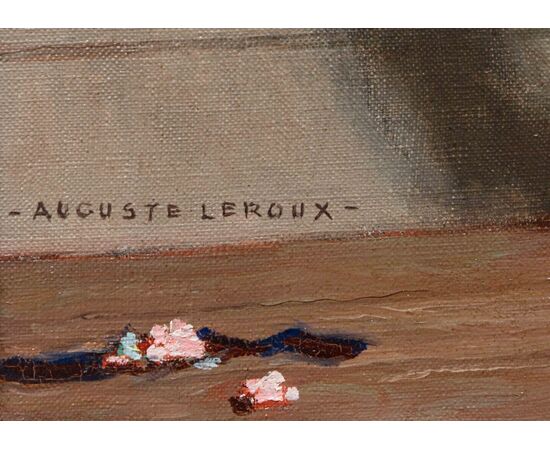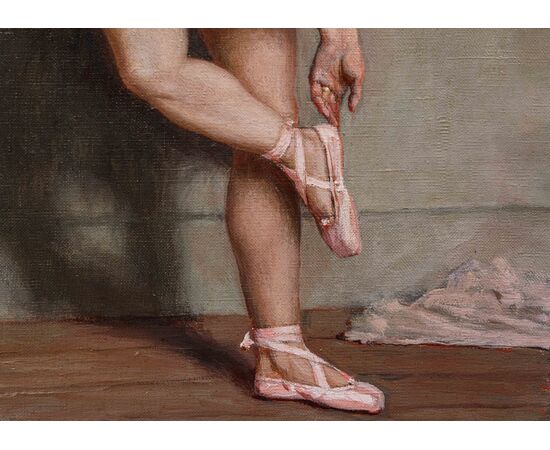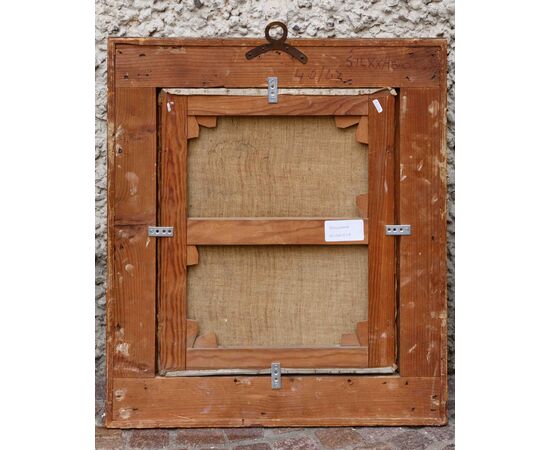Jules Marie Auguste Leroux (Paris, 1871 – 1954), Ballerina at the Barre
Jules Marie Auguste Leroux (Paris, 1871 – 1954)
Ballerina at the Barre
Oil on canvas, 63 x 53 cm
With frame, 46 x 39 cm
Signed lower left: “AUGUSTE LEROUX”
Jules Marie Auguste Leroux, the author of this canvas, as indicated by the signature in the lower left corner, was born in the third arrondissement of Paris on April 14, 1871, during the revolutionary period of the Paris Commune. Son of the print publisher Gustav Ferdinand Leroux, he entered the École nationale supérieure des arts décoratifs at a very young age, where he studied nude drawing, while working on fashion and children's illustrations, before being officially admitted to Léon Bonnat's studio at the École nationale supérieure des Beaux-Arts in 1892. He achieved many successes and medals for drawing during his school years, winning the first Grand Prix de Rome in 1894 with a painting depicting Judith presenting the head of Holofernes to the people of Bethulia (now kept at the National School of Fine Arts in Paris), allowing him to spend three years of study in Italy, at Villa Medici in Rome (1895 – 1898), accompanied by the French painter Adolphe Déchenaud and the musician Henri Rabaud. Upon his return to France, he exhibited at the Salon of French Artists in 1898 and won the bronze medal at the Universal Exhibition in Paris in 1900. During that period, he also participated in the decoration of various public buildings, executing some of the mosaics of the Basilica of the Sacred Heart in Paris with the four figures of Saint Dominic of Guzmán, Saint Bernard of Clairvaux, Jean Eudes, and Louis-Marie Grignion de Montfort for the Chapel of the Virgin. He was a professor at the École nationale supérieure des Beaux-Arts in Paris for thirty years, a member of the jury of the committee of the Society of French Artists in 1904, an art teacher at the Académie de la Grande Chaumière, and was appointed knight of the Legion of Honor. He died in Paris in 1954. Leorux exhibited in various galleries in Paris, including the Allard Gallery, the Georges Petit Gallery, the Charpentier Gallery, and the Mona Lisa Gallery. A multifaceted and critically acclaimed artist, Leroux had great success not only as a painter, but also as an illustrator of the literary and poetic works of Giacomo Casanova, Joris-Karl Huysmans, Honoré de Balzac, Gustave Flaubert, Stendhal, Anatole France, Jean Lombard, and many others, and as a lithographer, working with the greatest engravers of his time, such as Pierre Gusman, Eugène Decisy, Raoul Serres, Florian, and Jules-Léon Perrichon. Observing the corpus of his prolific production, it is possible to note a constant evolution of techniques and themes: his first works, in fact, were characterized by a strong symbolism and a decorativeness typical of Art Nouveau, mixed with numerous mythological references and allegorical subjects, unlike his more mature works, which showed, instead, a more classic rigor and greater attention to female anatomy. It is in this second artistic phase that we can place our Ballerina at the Barre, presented here with a graceful white tulle tutu adorned with small roses on the bodice and skirt, intent on adjusting her ballet slipper. The theme of the ballerina is addressed several times by the artist, seen as the embodiment of grace, movement, and inner strength. Unlike other artists like Degas who painted the world of dance with a more raw or documentary approach, Leroux tends to idealize them, rendering them almost mythological figures, often depicted in classic poses and with innate elegance, showing a perfect harmony between body and spirit. A master of soft lights and shadows, through which he builds a sense of real three-dimensionality, skilled in the use of pastel colors and delicate brushstrokes, he manages to recreate dreamy and evocative atmospheres. For the artist, the woman becomes a muse, a subject to be explored in all her facets, whether in a domestic context or in a moment of intimacy, revealing a profound sensitivity and great attention to psychological details: sophisticated, elegant, and endowed with a strong stage presence, his subjects move away from a purely decorative vision to seek a deeper meaning, where there is not a mere celebration of beauty, but a true investigation of femininity in an era of great social changes.
With Ars Antiqua, it is possible to spread all amounts up to a maximum of € 7,500 at ZERO RATE, for a total of 15 INSTALLMENTS.
Ex. Tot. € 4,500 = Monthly installment € 300 for 15 months.
Ex. Tot. € 3,600 = Monthly installment € 720 for 5 months.
For amounts exceeding € 7,500 or for a greater extension in time (over 15 installments), we can provide a personalized payment.
Contact us directly to get the best quote.
LIVE TV
– SUNDAY 17.00 – 21.00 Dig.terr. 126 - Sky 824
– Streaming on our website www.arsantiquasrl.com and on our social media Facebook and Youtube
All the works offered by Ars Antiqua are sold with a certificate of authenticity as required by law and an accurate information sheet.
It is possible to see the works directly at the Milan showroom gallery, in via Pisacane 55 and 57.
We personally organize transport and delivery of the works, both for Italy and abroad.

